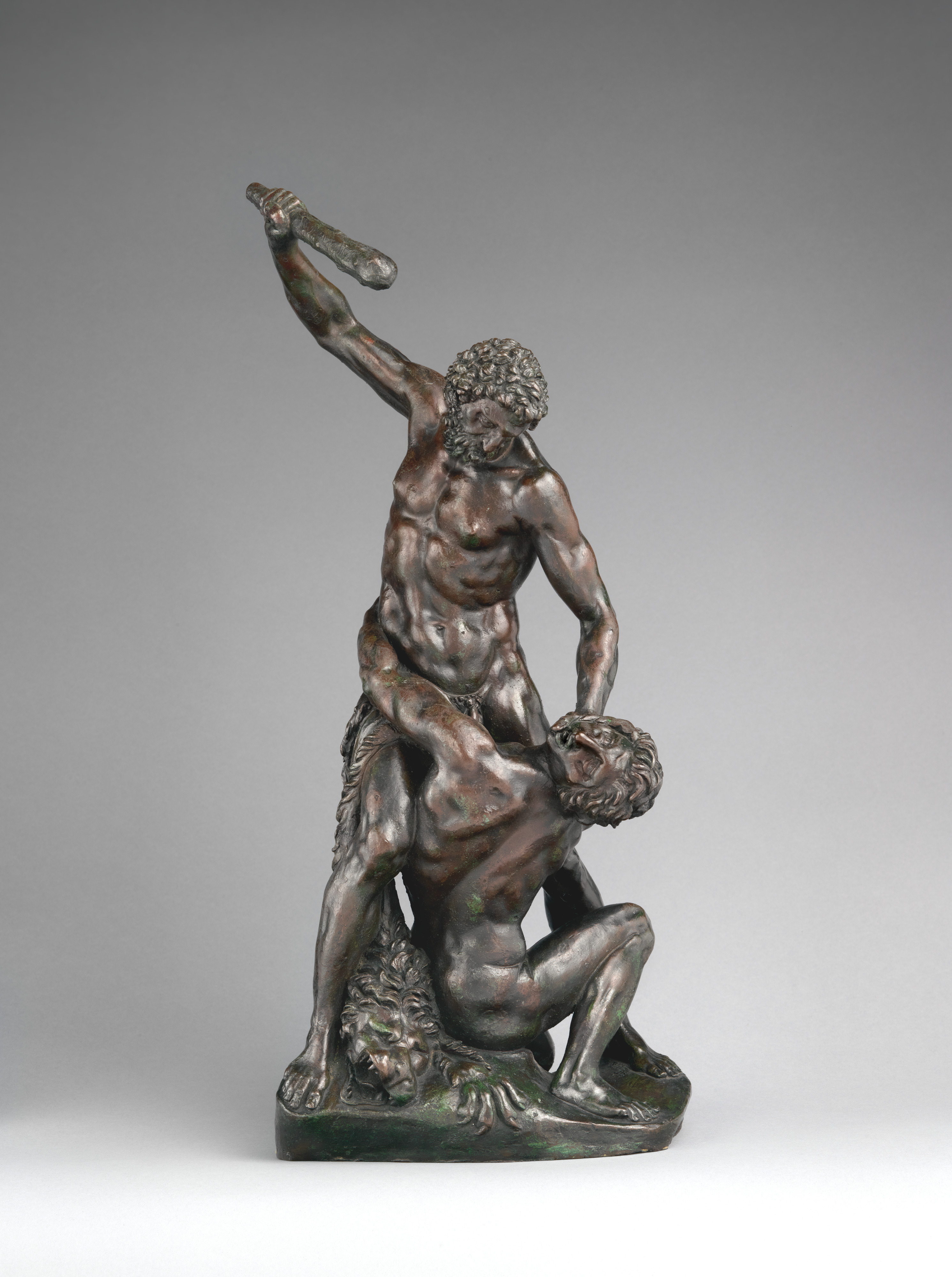Hercules and Cacus
After a model by Michelangelo Buonarroti Italian
Not on view
Before entering the collection of Michael Friedsam, this Hercules and Cacus was sold at auction in April 1923 with the estate of William Salomon, a New York collector whose sumptuous home at 1020 Fifth Avenue was a treasure trove of important works such as Lorenzo di Credi’s Portrait of a Young Man today in the Galleria Sabauda, Turin. The statuette, attributed to Giambologna at the time, had once been owned by Jacques Seligmann, the well-known art dealer who worked between Europe and the United States. In his memoirs, Germain Seligman recalls Salomon as one of the collectors of bronzes, along with Henry Walters and Clarence Mackay, who frequented his father’s gallery at the beginning of the twentieth century.[1]
Friedsam’s bequest to The Met of fifty or so bronzes included the present statuette, and in 1932 it was installed in the museum’s galleries, assigned to a sixteenth-century Florentine artist, possibly Vincenzo Danti, inspired by ancient models.[2] Hans Weihrauch reevaluated the attribution in 1967, noting the bronze’s resemblance to “a preliminary design for Vincenzo de’ Rossi’s marble group of Hercules and Cacus, executed before 1568 for the Palazzo Vecchio,” a suggestion not met with particular favor in subsequent scholarship on de’ Rossi. The purported Florentine origin of the Friedsam Hercules was likely based on its compositional affinity with notable Tuscan precedents of figures in combat. These include the Michelangelesque pensiero for a Samson and the Philistines, replicated in a copious sequence of small-scale bronzes (see cat. 98); Giambologna’s monumental marble statue of the same subject executed between 1560 and 1562 (V&A); and Herculean figures from his workshop such as Hercules Wielding His Club—of which there is a fine example in the Bargello—and Hercules Slaying the Hydra, made in silver for the Tribuna degli Uffizi between 1578 and 1582, and to which is associated a wax model in the Palazzo Vecchio.[3]
Careful examination, however, challenges the notion of a Florentine provenance or even a sixteenth-century dating for our bronze. There is a peculiar slickness on the internal cavities visible from the underside. The support displays an atypical conformation to the figures’ bodies and poses. A grimacing leontè incongruously stretches out on the base, its claws hanging over the edge. The patina is inconsistent with those widely used in cinquecento Florence; indeed, the greenish brown “archaeological” coloring smacks of a deliberate attempt to mimic the effects of oxidation caused by long burial.
The complex zigzagging and intertwining of the figures of the demigod and his adversary in a chaotic struggle align the composition not with the aforementioned Tuscan groups but rather the centrifugal variations adopted by Northern artists on the theme of “victor and vanquished” produced from 1550 to 1650. Examples of these types include Willem van Tetrode’s Hercules and Cacus and Adriaen de Vries’s Cain and Abel, works clearly influenced by “Italianate” culture but nevertheless original in their formal solutions.[4] Echoes of similar designs can be found in later casts, such as a Hercules and Cacus in the Fondation Bemberg, Toulouse, and another in the Walters Art Museum, Baltimore, as well as many more sculptures in various materials (from bronze to wood and ivory) on a timeline that would place them toward the end of the seventeenth century.[5]
The proliferation of kindred compositions, all attributed to German and Dutch artists,[6] suggests that The Met’s bronze also comes from north of the Alps. And, given stylistic evidence such as the incongruous base and verdigris patina, one cannot rule out the possibility that it is a copy of a much older composition, perhaps lost or not yet identified.
-TM
Footnotes
(For key to shortened references see bibliography in Allen, Italian Renaissance and Baroque Bronzes in The Metropolitan Museum of Art. NY: The Metropolitan Museum of Art, 2022.)
1. Seligman 1961, p. 110.
2. Friedsam Papers, MMA Archives.
3. V&A, A.7-1954; Bargello, 362 B; Palazzo Vecchio, MCF-LOE 1933-4. For the latter two bronzes, see Serena Pini in Paolozzi Strozzi and Zikos 2006, pp. 182–85, cats. 13, 14.
4. The Tetrode cast was auctioned at Sotheby’s, New York, January 30, 2014, lot 116, and is now in the Hill collection; versions of the de Vries bronze are in the Statens Museum for Kunst, Copenhagen (5492) and at the University of Edinburgh, Scotland (49). See Thomas DaCosta Kaufmann in Scholten 1998, pp. 192–94, 230–31, cats. 29, 38.
5. For the Bemberg bronze, see Cros 1996, pp. 137–40; for the one in Baltimore (54.248), see Spicer 1995, p. 27.
6. Including Leonhard Kern and David Heschler; see Theuerkauff 1973, pp. 166–67.
Due to rights restrictions, this image cannot be enlarged, viewed at full screen, or downloaded.
This artwork is meant to be viewed from right to left. Scroll left to view more.



